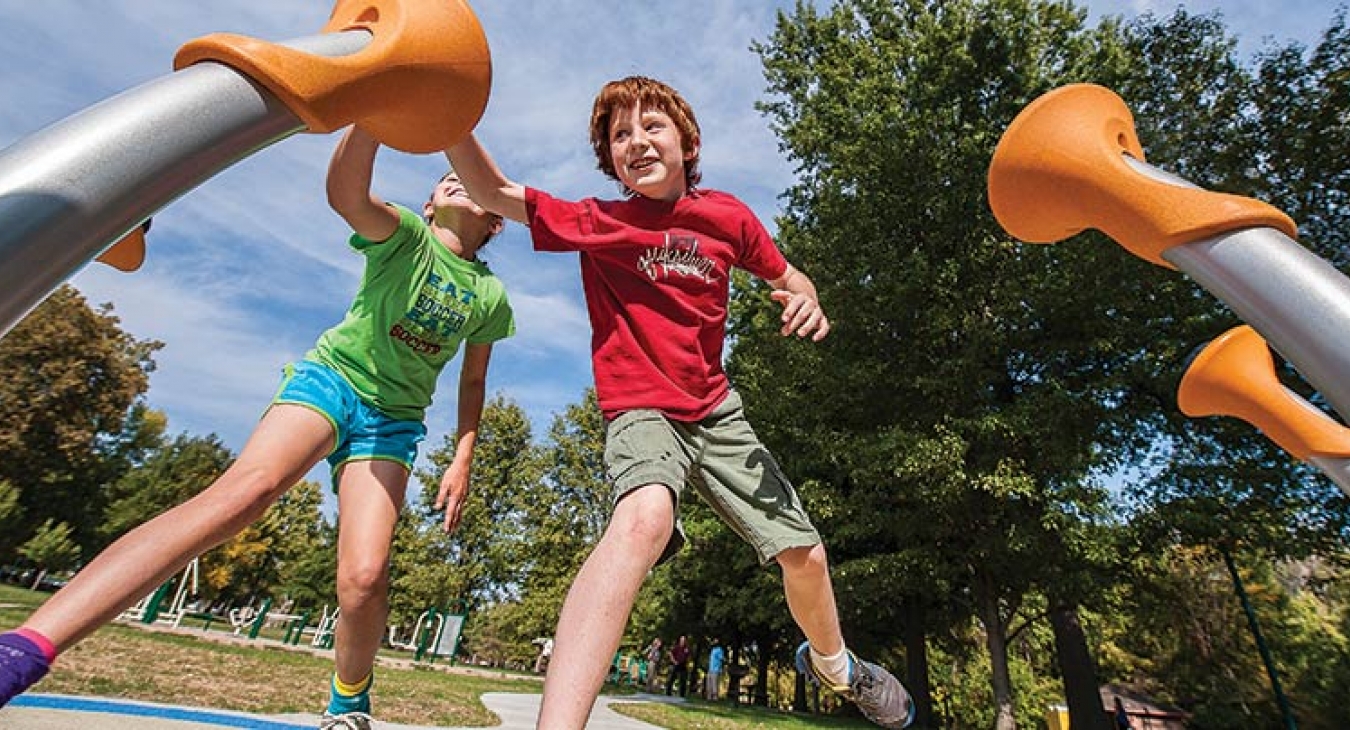How vital are playgrounds in today’s society? For many people, unstructured outdoor play is viewed as a luxury, not a necessity. As a result, children don’t devote as much time in unstructured outdoor play as they did decades ago.
Multiple societal forces – both positive and negative – are affecting people’s perception of the importance of play in their lives. One factor disrupting the amount of outdoor play time is the over-scheduling of family life. Free time, for both children and adults, is rare. Schoolwork, extracurricular activities, and chores fill daily calendars, edging out opportunities to roam around freely outdoors. Many parents have concerns about their children’s safety outside the home – whether the threat is as minimal as a skinned knee or as extreme as “stranger danger.”

Instead of running out the door to play after homework and other responsibilities are finished, today’s children often turn to television, video games, and other electronic gadgets to decompress from their busy lives. Technology vies for children’s time, and all the while, parents are dealing with the demands of balancing work and home life.
According to Howard Chudacoff, author of Children at Play: An American History (2007), “Beginning around 1960 or a little before, adults began chipping away at outdoor unstructured play by increasing the time that children had to spend at schoolwork and, even more significantly, by reducing children’s freedom to play on their own, even when they were out of school and not doing homework. Adult-directed sports for children began to replace ‘pickup’ games; adult-directed classes out of school began to replace hobbies; and parents’ fears led them, ever more, to forbid children from going out to play with other kids, away from home, unsupervised.”
Today, children get 50 percent less unstructured outdoor play time than kids of the 1970s, according to the not-for-profit advocacy group The Alliance for Childhood. Childhood obesity is just one negative outcome of this new reality. Unstructured outdoor play is a necessity for raising happy, healthy children. Without play, kids’ cognitive development, creativity, and socialization skills suffer. Play takes away stress, reduces obesity, and promotes spiritual development. It also unites us and strengthens our sense of community.
Play is not a luxury — through play, children develop their entire being: physically, creatively, cognitively, socially, and emotionally. In Free to Learn, developmental psychologist Dr. Peter Gray states that our children, if free to pursue their own interests through play, will not only learn all they need to know, but will do so with unbounded energy and passion.
Unstructured outdoor play helps children develop into thoughtful, capable adults by presenting them with risks they must learn to handle appropriately. According to clinical psychologists Drs. Susan Davis and Nancy Eppler-Wolff (Children Who Soar: A Parent’s Guide to Helping Children Take Good Risks (2009)):
“Risk is inevitable, and without learning the skills of good risk-taking, our children will be more apt to take impulsive and poor risks. Through the development of thoughtful risk-taking, children will be better equipped to leap at life’s opportunities, and to rebound from life’s disappointments. Learning to take smart risks early on prepares them to recognize and think through issues of safety and danger. They will have had experience identifying the challenge and the risk, and have worked with parents and teachers on how to proceed to the next step, using their intellect and emotional skills. They are also better able to struggle more tenaciously through failures because they have experienced small setbacks.”
In the past, outdoor areas for recreation and play were a vital part of the community. In order for parks and playgrounds to once again be viewed that way, the industry must meet the needs of people today. We must create relevant outdoor play experiences based on the unique value outdoor play holds for today’s society. Only when we acknowledge the reality and discover the current value proposition can we begin to reinvent the traditional playground to make play essential to everyday life now.
How can we design and manufacture equipment to make outdoor play relevant given all the current forces keeping children indoors? How do we make outdoor play matter once again?
We must place value on the limited time children have for unstructured outdoor play and make it more meaningful. Everything we do should be based on the tenet that children have a fundamental human right to access a place outdoors where they set the rules, engage and interact freely, and discover their abilities on their own terms. Our industry must be more thoughtful than ever before about the equipment we design and manufacture. The play experience should be purposefully designed to delight today’s children and keep them engaged. The focus should be on producing equipment that embraces and encourages creativity and community-building in a world where many people prefer solitary digital interactions.
Technology is all-pervasive and the role it plays in everyday life will only continue to increase. It is therefore an essential ingredient in our re-imagination of the playground. To connect with the needs of today’s children and families, playground experts must embrace the irresistible attraction of technology and combine it with all the unparalleled possibilities the natural world holds.
Saving play doesn’t mean shunning technology; it means connecting digital and physical worlds to reinvent the outdoor playground. The hi-tech world and unfettered outdoor play cannot be mutually exclusive. We must find ways to leverage technology to create unique play experiences each and every time a child visits an outdoor play space – whether it’s creating a digitally empowered scavenger hunt through the woods or bringing the sound and lights of video games onto the playground. It is equally essential to offer outdoor opportunities where people can disconnect and escape from their digital world if they choose to do so. Much the way museums provide an opportunity for guests to use a guided audio tour or not, playgrounds can include tech-charged features and peaceful aspects too.
As an industry, we must ask ourselves: If we were to invent playgrounds now, what problems would they solve? What challenges would we tackle? To endure, today’s playgrounds must offer value on today’s terms. We can accomplish that by understanding and connecting the realities of today’s society to the priceless feelings unstructured outdoor play evokes. By shifting our thinking away from selling a product to creating an experience people can’t live without, we will save play for future generations.



















Add new comment